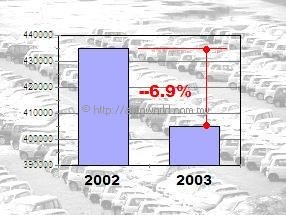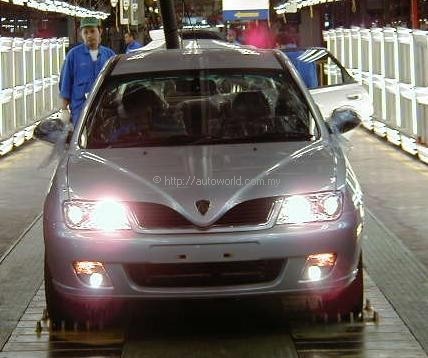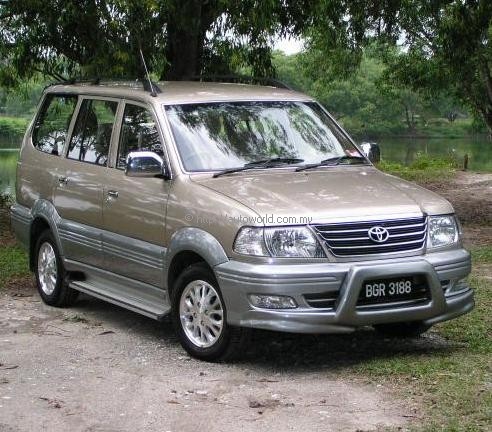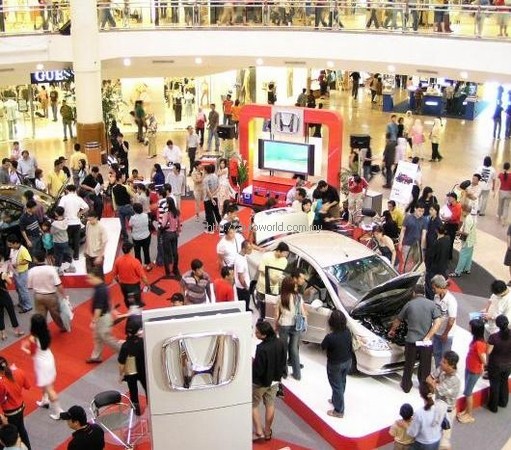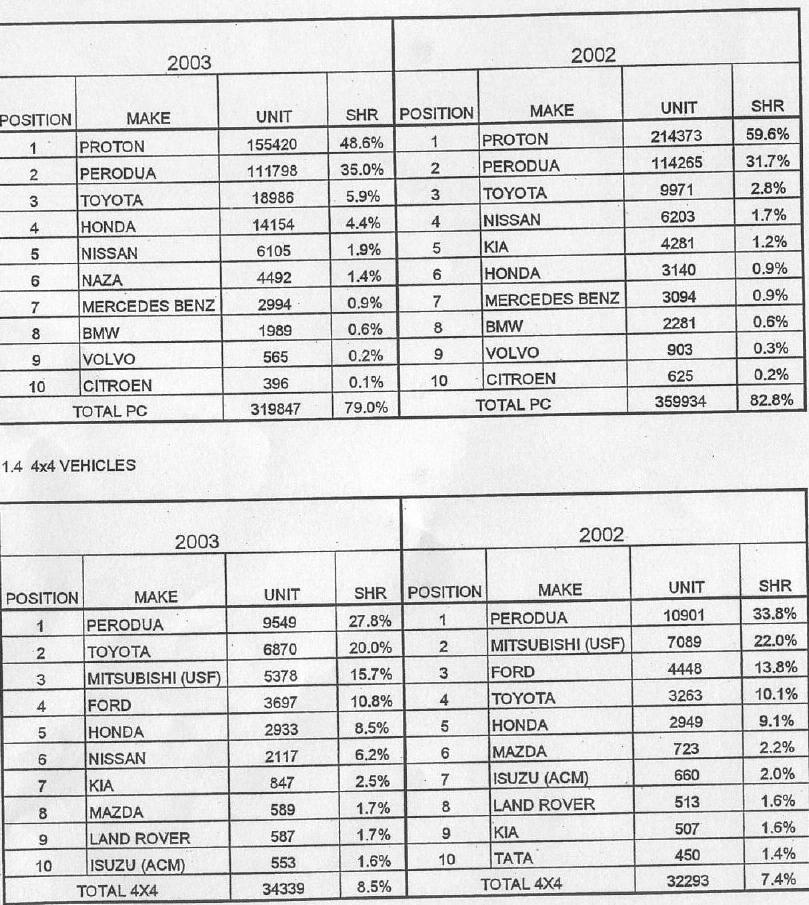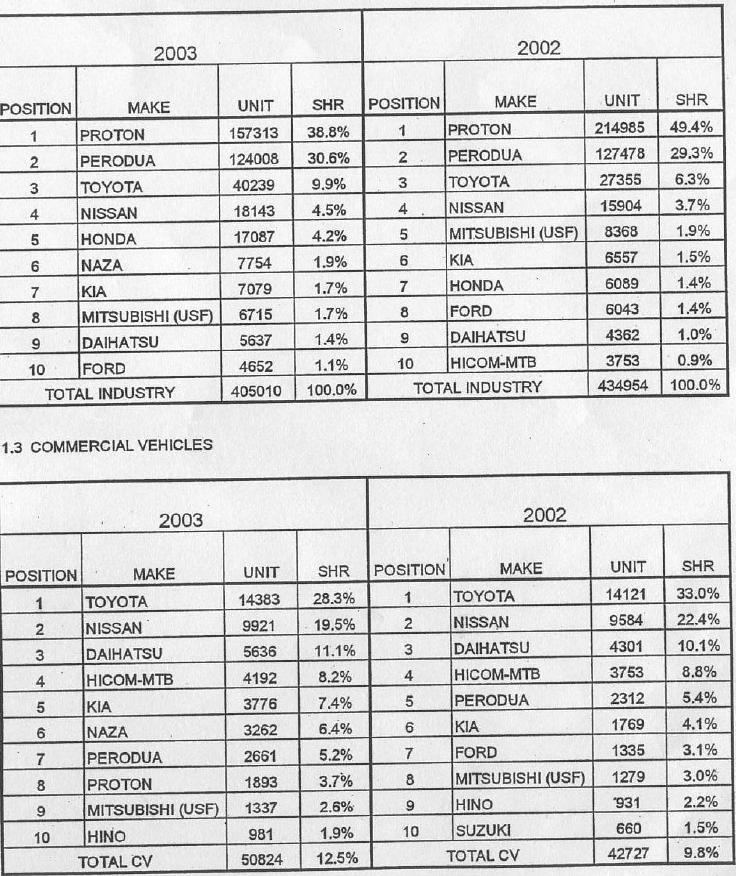Decline in 2003 Sales & Production
After the boom of 2002, the local automobile industry experienced a drop in total industry volumes (TIV) to 405,010 units, which was 6.9% lower than the 2002 TIV of 434,954 units. Even if you add in Hyundai sales, which were not included as Oriental-Hyundai is not a member of the Malaysian Automotive Association (MAA) and does not contributes its sales/production data, the TIV would probably be in the region of 413,000 units.
Malaysia was the only country among the ASEAN 4 (Thailand, Indonesia, Philippines and Malaysia) which recorded a decline in TIV in 2003. According to Aishah Ahmad, President of the MAA, unofficial data indicates that the other countries had about 7 – 8% growth last year.
“While some global and regional events affected consumer sentiment, the drop in sales in Malaysia was due largely to the ‘wait-and-see’ attitude of consumers who were expecting prices to fall when the government revised its tariff structure in preparation for AFTA,” she said.
“Now that the government has introduced the new tariff structure and we all know how prices will change, the market will hopefully pick up during 2004 with a modest increase of 5% to 425,000 units,” added Cik Aishah. “Our association feels that the country’s economic growth will remain strong and this should create an environment of optimism among businesses and consumers, with positive effects on sales.”
So what happened in 2003? As is well known now, the leading national carmaker Proton saw its sales decline substantially and in the full year, its share of the passenger car (PC) segment fell to 48.6% from 59.6%. This translated into a fall in sales volume from 214,373 units in 2002 to 155,420 units in 2003.
Perodua’s volume fell too – from 114,265 units to 111,798 units in the PC segment – but its market share rose from 31.7% in 2002 to 35% in 2003. When its commercial vehicles (CV) and 4WD models were included, its total volume was 124,008 units which gave it 30.6% market share, a marginal improvement for 2002’s share. Proton, without stronger representation in the other segments, saw its overall market share fall to 38.8% from 49.4%.
According to the MAA’s data, the volume of national models sold (in all segments) totaled 293,443 units in 2003, 15.3% lower than the volume for 2002. This was in spite of the inclusion of the Kia Spectra (which was designated a ‘national car’ from May 2003) and also the Naza Ria. Hicom and Inokom products also receive special privileges and are regarded as ‘national makes’ as well.
While national makes seemed to lose popularity, non-national makes enjoyed greater sales to total 111,567 units or 25.9% higher than in 2002. Among the non-national makes, Toyota continued to be the best-seller with a total of 40,239 units sold and a 9.9% share of the TIV. Toyota’s strength was in its CV segment where the Unser is classified and in fact, the 14,383 units in this volume were the highest among CVs and accounted for a 28.3% share. In terms of PCs alone, Toyota’s volume was double its 2002 figure at 18,986 units which was 5.9% of the PC segment and the highest; next was Honda which sold 14,154 cars and had a 4.4% share of the PC segment (and 4.2% of TIV). Its increase in PC sales was very impressive too – 4 times more than in 2002 but then again, 2002 had been a really bad year for them. However, Nissan was behind Toyota in terms of overall sales volume with 18,143 units sold and like Toyota, its largest volume was in CVs.
Naza, the youngest brand in Malaysia, grabbed 7th overall position with 7,754 units sold while Kia was 8th with 7,079 units sold.
Among the European makes, Mercedes-Benz, at 13th overall position, was the best performer with 3,306 units sold, 2,994 of them PCs. BMW (No. 14) sold 2,145 units, of which 156 units were the X5 SUV. Volvo was positioned at No. 15 with 1,097 units (this includes Volvo trucks), about a third of the volume taken by the XC90. The highly-rated SUV certainly helped Volvo almost match its 2002 volumes (excluding trucks) as PCs alone saw a decline in sales.
Among the three segments – PC, CV and 4WD – it was the CV segment which saw the highest growth of 19% while the PC segment saw a drop of 11.1% in volumes. The growth of the CV segment mirrors the economy of the country and as it has been steadily growing, business has improved and fleet purchases have increased. The boom in the retail industry has also fuelled demanded for CVs, especially in the smaller range which is required for urban logistics.
Looking at the production figures, it’s interesting that the reduction in output was 7% compared to 2002, fairly close to the fall in TIV for 2003. The greatest volume reported in 2003 was by Proton which had production from two plants (the other is a contract assembler in Pekan, Pahang, which does the Iswara) totalling 165,018 units, 67,163 units less than what it made in 2002 or a reduction of 29%. Of its total output, 6.072 were CVs, which were the Arena pick-up.
So if you make a rough estimate of production versus sales, Proton would have produced a surplus of 7,705 units during 2003; however, if you factor in its production in 2002 which was 232,181 units against total domestic sales of 214,985 units, then there would be a surplus of 24,901 units over the 2-year period. This does not, of course, consider the exports which Proton officially states as being ‘less than 10% of total output’ (an industry analyst calculated that Proton’s export volumes are about 5% of its production at the moment).
Perodua’s production was lowered by 2% for 2003 and a total of 130,680 vehicles were produced which means 6,672 units surplus. Like Proton, though, Perodua also exports some of its production so the actual surplus is hard to gauge.
Apart from Proton and Perodua, the most productive plant in Malaysia was Assembly Services Sdn Bhd (ASSB) which is owned by UMW Toyota Motor. The plant in Shah Alam, Selangor, assembles Daihatsu, Hino and Toyota vehicles and in 2003, its output was 46,133 units, of which Toyota vehicles alone accounted for 87%. Its output was 37% higher than that of 2002 when it did 33,624 units.
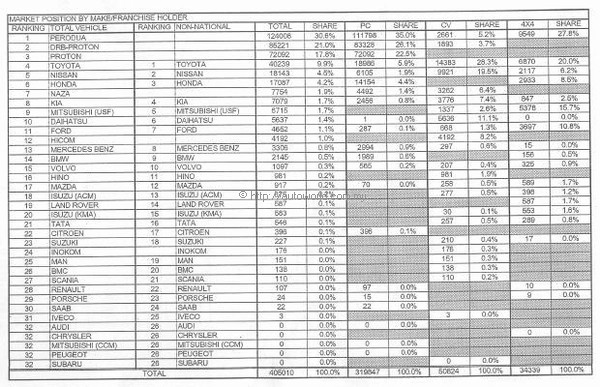 |
| Compiled by MAA |




